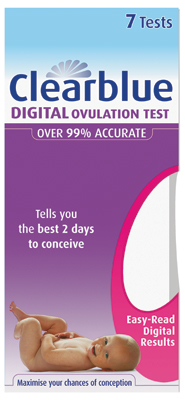Clearblue Digital Ovulation Tests

Clearblue Digital Ovulation Tests
More than half of all Australian women could be trying to get pregnant at the wrong time. In a recent study of 509 Australian women, 55 per cent of those surveyed could not identify the best time to conceive during their menstrual cycle.As many as 36 per cent incorrectly identified 1-2 days after ovulation as the best time to conceive a baby. In fact, the best time is the day before and the day of ovulation. The average lifespan of a woman's egg is only 24 hours, therefore correct timing is important to conceive. A further 17 per cent of women admitted they do not know the best time to conceive at all.
Obstetrician and Gynaecologist at North Shore Private Hospital, Dr. Michele Batey says she encounters this problem in her Sydney practice on a regular basis. "After trying for a few months without much luck, women come to see me to ask for advice on how to get pregnant," said Dr. Batey. "When I tell them there are only a few days in each cycle when they can conceive, or when they are at their most fertile, they usually find it a lot easier to conceive after that. The hard part is figuring out when you're ovulating."
The survey, conducted by the world's leading brand in home pregnancy and fertility testing, Clearblue, indicates that as few as 17 per cent of women who are likely to have a baby in the future know when they are ovulating, with older women more likely to be in tune with their menstrual cycle than their younger counterparts.
Three in four of the women surveyed were aware of the different methods that could be used to track ovulation including checking basal body temperature, at-home ovulation urine testing, online ovulation calculators, and electronic fertility monitors. Despite this high level of awareness, over 80 per cent of the women had never tracked their ovulation using these popular methods. Among those women who have had a baby in the past, the at-home ovulation urine test was rated most successful.
"Simple products such as an ovulation urine test can take the guess work out of conceiving a baby. Many women have an irregular cycle which makes it difficult to estimate when they are ovulating. It can be a stressful time for a lot of couples and knowing when you have the best chance of conceiving makes it less stressful," said Dr. Batey.
The Clearblue Digital Ovulation Test is proven to be more accurate than temperature, the basal body temperature method (BBT), at identifying the most fertile days, and is more than 99 per cent accurate in detecting the surge in Luteinising Hormone (LH) in urine. The LH surge occurs 24-36 hours prior to ovulation. Within three minutes, clear results are indicated on a digital screen without the hard-to-read lines. The appearance of a smiley face indicates that the LH surge which precedes ovulation has been detected.
Available in packs of seven, the Clearblue Digital Ovulation test also gives women a higher chance of finding their most fertile days when compared with five-pack test kits. When used each day on the days around the time in the cycle when the LH surge is expected (the instruction leaflet explains when and how to test), the user can identify the two days each cycle when she is most fertile and, therefore, most likely to get pregnant.
The Clearblue Digital Ovulation Test is available nationally from major supermarkets and pharmacies in a pack of seven tests (RRP $69.99). For more information on the Clearblue Digital Ovulation Test and other products in the range, visit www.clearblue.com/au or call Clearblue's Careline on 1800 125 021.
MORE
- Midwife Cath Interview
- Colin Anson Interview
- Why Good Health is Essential to Increase Fertility
- 5 Beauty Products to Avoid When You are Pregnant
- Looking After You, Looking After Your Baby
- Andre Carvalho International Pregnancy and...
- NRL Player v Mums
- Safer Internet Day
- The Pink Elephants Support
- Edwina Sharrock Birth Beat Interview
- Make Mums Group Dad-Friendly



